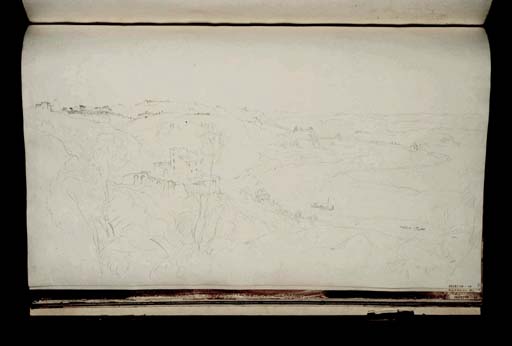Joseph Mallord William Turner The River Tiber, Rome, with the Ponte Molle, the Fontana dell'Acqua Acetosa and a Distant View of St Peter's 1819
Image 1 of 2
-
 Joseph Mallord William Turner, The River Tiber, Rome, with the Ponte Molle, the Fontana dell'Acqua Acetosa and a Distant View of St Peter's 1819
Joseph Mallord William Turner, The River Tiber, Rome, with the Ponte Molle, the Fontana dell'Acqua Acetosa and a Distant View of St Peter's 1819 -
 Joseph Mallord William Turner, The River Tiber, Rome, with the Ponte Molle, the Fontana dell'Acqua Acetosa and a Distant View of St Peter's 1819 (Enhanced image)Enhanced image
Joseph Mallord William Turner, The River Tiber, Rome, with the Ponte Molle, the Fontana dell'Acqua Acetosa and a Distant View of St Peter's 1819 (Enhanced image)Enhanced image
Joseph Mallord William Turner,
The River Tiber, Rome, with the Ponte Molle, the Fontana dell'Acqua Acetosa and a Distant View of St Peter's
1819
Joseph Mallord William Turner 1775–1851
Folio 50 Recto:
The River Tiber, Rome, with the Ponte Molle, the Fontana dell’Acqua Acetosa and a Distant View of St Peter’s 1819
D16138
Turner Bequest CLXXXVII 50
Turner Bequest CLXXXVII 50
Pencil on white wove paper, 255 x 403 mm
Inscribed by John Ruskin in blue ink ‘50’ bottom right, descending right-hand edge
Stamped in black ‘CLXXXVII 50’ bottom right
Inscribed by John Ruskin in blue ink ‘50’ bottom right, descending right-hand edge
Stamped in black ‘CLXXXVII 50’ bottom right
Accepted by the nation as part of the Turner Bequest 1856
References
1909
A.J. Finberg, A Complete Inventory of the Drawings of the Turner Bequest, London 1909, vol.I, p.556, as ‘The Tiber, with St. Peter’s in the distance’.
A large number of studies from the Naples: Rome C. Studies sketchbook represent variant views of the Roman Campagna, the area of countryside encircling the outskirts of the Eternal City (Tate D16122–D16139; Turner Bequest CLXXXVII 34–51). This sketch depicts a view of the landscape to the north of Rome from a point near the Fontana dell’Acqua Acetosa, a seventeenth century fountain designed by Andrea Sacchi which can still be seen today. The waters of the fountain had an acidic taste (aceto is the Italian word for vinegar) and were believed to be good for the health. Along the horizon on the far left is the distant dome of St Peter’s whilst further to the right are the heights of Monte Mario topped by trees and the Villa Mellini. In the middle distance, the smaller slopes of Monte Parioli lead down towards the River Tiber and the Ponte Molle, an ancient bridge. The river winds its way upstream towards the viewer, past the Torre Lazzaroni beside the curved bank on the right and the Fontana dell’Acqua Acetosa itself, visible on the opposite side, to the immediate left of the small boat. The building in the foreground on the left is unidentified but it appears to be a small villa.
By the nineteenth century, exploration of the city’s environs had become as much part of the Roman experience as its architecture and monuments. Turner’s forays into the Campagna followed a long artistic tradition established during the seventeenth century by Claude Lorrain (circa 1600–1682) and Nicolas Poussin (1594–1665). The two French masters had famously made a number of sketching trips along the banks of the Tiber north of the city; indeed this part of the Roman Campagna was informally known as the ‘Promenade de Poussin’, reflecting its association with Poussin who famously sketched here during solitary, meditative walks out of the city from the Porta del Popolo.1 Turner may have been particularly mindful of the paintings of Claude Lorrain. A cylindrical building similar to the tower within this sketch appears in Claude’s The Mill on the Tiber, 1650 (Nelson–Atkins Museum of Art, Kansas City) and The Mill, or the Marriage of Isaac and Rebecca, 1648 (National Gallery, London). The latter was one of two paintings by the French master which Turner requested should be hung in perpetuity next to his own Sun rising through Vapour and Dido building Carthage.2
See Richard Verdi, ‘Poussin’s Life in Nineteenth-Century Pictures’, Burlington Magazine, vol.111, no.801, December 1969, p.742; and Peter Galassi, Corot in Italy: Open-Air Painting and the Classical-Landscape Tradition, New Haven and London 1991, pp.162–3.
Verso:
Blank, save for inscription by an unknown hand in pencil ‘[?M]’ bottom right, ascending right-hand edge
Nicola Moorby
April 2009
How to cite
Nicola Moorby, ‘The River Tiber, Rome, with the Ponte Molle, the Fontana dell’Acqua Acetosa and a Distant View of St Peter’s 1819 by Joseph Mallord William Turner’, catalogue entry, April 2009, in David Blayney Brown (ed.), J.M.W. Turner: Sketchbooks, Drawings and Watercolours, Tate Research Publication, December 2012, https://www

